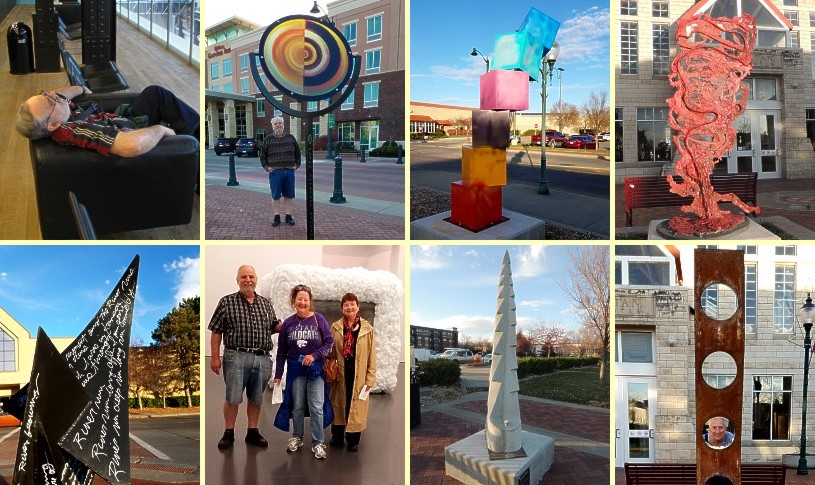Kansas Snapshots by Gloria Freeland - November 20, 2020
Art with Art
Saturday was a beautiful autumn day - 65 degrees and sunny, a blue sky streaked with white wispy clouds. It seemed the perfect day
to wander downtown Manhattan to see some recent outdoor modern-art installations with husband Art.
This type of art is something we sometimes like, while at other times just find perplexing. When we visited the Tate Modern in London,
with its displays fixed to the walls, ceilings and floors, Art "experienced" one "work" for about 30 seconds before realizing it was
a ventilation grill. One of the actual displays consisted of a film loop where a man lit a cigarette, took a puff and then looked
out over a body of water. Art declared some seemed to be little more than "happy horse-s---."
We began our walk Saturday at the south end of the 3rd Street commercial area, where "Magnify" was installed. From a distance, it
looked like a giant lollipop. Artist Kirk Seese said, " ... This interactive, kinetic sculpture acts as a giant magnifying glass.
Sunbeams pour through the colored �lens� as the viewer swivels the rings into position to catch the light, casting a stained glass
reflection on the ground, or anything else it hits."
Art said it reminded him of a navigational gyroscope.
Emily Weiskopf's "Re:" consisted of yellow intertwining aluminum strips. She said its title comes from "... a process of mobilizing
to Re-imagine, Resilience, Re-direct, Re-cycle, Re-generate, Re-learn, Re-build, Re-lease and Re-ceive, to bring Re-newal to
ourselves, our lives, our planet, our hope and need of healing ..."
Art marveled at her welding.
"Red" was made of small wooden shelves fastened together and painted - you guessed it - red. "My work consists of the utilization
of found objects, said artist Joelle Ford. "... My parents and grandparents, who lived through the Depression, taught me how to
make doll beds out of shoe boxes, and clothes from feed sacks. ..."
I can relate to that. My parents and grandparents lived through the Depression, too - and I made doll beds out of boxes when I was
a girl. Art said they made him think of shelves painted red.
Our contrasting reactions to the various pieces begged a question perfectly stated in a January 2019 brainworldmagazine.com blog
titled, "Mysteries of Modern Art, Or Why Some People Hate or Love It." It arose from author Rania Hanna�s visit to a modern art
museum in Washington, D.C.:
... With the random wire sculptures and the torn canvases, the splotches of paint dripped or flung, and even the pantyhose filled
with potato[es], I disliked looking at anything. In fact, I mocked the so-called art. My friends who also didn�t enjoy the experience
made the mocking that much more fun. I thought this "modern art" was vapid and meaningless ...
Her comments reminded me of our summer 2019 visit to the Centre Pompidou-Metz in France. We and three friends poked fun at the large
display of rocks, pipes and cotton that looked as if it had recently been removed from medicine bottles. Upon seeing one particular
print, three of us couldn't decide if the tiny black strokes were meant to be commas or apostrophes. The fourth, who had seemed a
bit reticent in commenting, eventually said they reminded her of one ingredient needed to initiate a pregnancy! Needless to say, we had a
grand old time.
But a 2006 American Psychological Association article, "Lack of meaning may spur some to dislike modern art," suggested a reason
why we like or don�t like contemporary art.
Open, creative engagement with art can be inspirational. But for certain people, modern art's lack of apparent meaning can cause
them to miss out on the benefits and rich experience of art ...
... The studies suggest that although modern art aims to encourage people to consider the world beyond their own experiences or
knowledge, it may fail to do so - for certain people - when its images are completely unrecognizable. However, when the piece is
imbued with meaning - by way of a title or explanation of the piece's composition - the effect is eliminated, suggesting that
artists can attach meaning to their work without altering its content.
That may explain why I seemed to enjoy these pieces more than some others I have seen and more than Art did. I read about the
artists AND their explanations of their artwork, which gave them meaning.
Both of us thought "Fire Tornado," looked like something a person might see in an Asian restaurant - bright red and with no definite
shape, but more vertical than horizontal. But having lived in the Flint Hills of Kansas for most of my life, I am familiar with
the image the artist described. John Hachmeister said the sculpture "references the phenomenon of 'fire tornados' that erupt on
occasion when burning grasses in the Flint Hills ... When the fire and breeze are right, two mini tornados rush down the fire line.
On the grass side, it's a column of flames swirling 30 to 40 feet into the sky, and on the burned side of the fire line it is a
sister column of black ash."
Alan Tollakson's "Petrified Forest" looked like a tall skinny stone Christmas tree. The limestone piece said it "addresses the
ever-present, immense scale of nature that looms over human existence. For some, the enormity of creation can also be petrifying,
as the small house indicates ..."
Art said it reminded him how insignificant people are compared to nature.
Artist Kati Toivanen said, "I cherish the opportunity to activate public spaces with art in order to engage viewers ... I hope to
disrupt everyday routines by providing moments of surprise and by inviting conversation ..."
Mission accomplished. The sculptures were just the ticket to make a beautiful day of art with Art even a bit more extraordinary.
